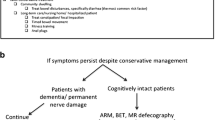Summary
Faecal incontinence is a challenging clinical condition in the elderly diabetic patient and has a significant impact on the overall quality of life, but is often neglected by the care giving professionals. Up to 22 % of diabetic patients have faecal incontinence depending on the definition applied. Multiple factors are almost always involved in the pathophysiology of faecal incontinence, including physiological age-related changes, diabetic neuropathy, multimorbidity and polymedication. As for constipation, the use of a stepwise approach for the diagnosis of faecal incontinence is highly recommended. The verification of the diagnosis and underlying causes of faecal incontinence are important for improving the quality of life, as well as the employment of the appropriate therapy particularly in the case of the elderly diabetic patient. Treatment options include, in addition to an optimised blood sugar control, the use of conservative measures, bio-feedback therapy and surgical interventions.
Zusammenfassung
Stuhlinkontinenz ist ein schwerwiegendes klinisches Problem, gerade auch des älteren Diabetikers. Trotz der hohen Bedeutung für die Lebensqualität der Betroffenen wird sie häufig noch in der Betreuung tabuisiert. Je nach Definition der Stuhlinkontinenz sind bis zu 22 % der Diabetiker davon betroffen. Pathophysiologisch handelt es sich fast immer um ein multikausales Geschehen (physiologische Alternsveränderungen, verschiedene diabetische Neuropathien, Multimorbidität und Multimedikation). Wie bei der Obstipation empfiehlt sich auch bei der Stuhlinkontinenz nach einem Stufenplan vorzugehen. Die Sicherstellung der Diagnose einer Stuhlinkontinenz ist entscheidend, um gerade auch älteren Patienten eine Verbesserung der Lebensqualität durch eine zielgerichtete Therapie zu ermöglichen. Verschiedene Behandlungsoptionen stehen neben einer optimierten Blutzuckereinstellung und Überwachung zur Verfügung, einschließlich konservativer Maßnahmen, Biofeedback-Therapie oder chirurgische Manipulationen.
Similar content being viewed by others
Author information
Authors and Affiliations
Corresponding author
Rights and permissions
About this article
Cite this article
Füsgen, I., Gruss, HJ. Faecal Incontinence in the Elderly Diabetic Patient. Wien Med Wochenschr 153, 398–401 (2003). https://doi.org/10.1007/s10354-003-0022-3
Published:
Issue Date:
DOI: https://doi.org/10.1007/s10354-003-0022-3




